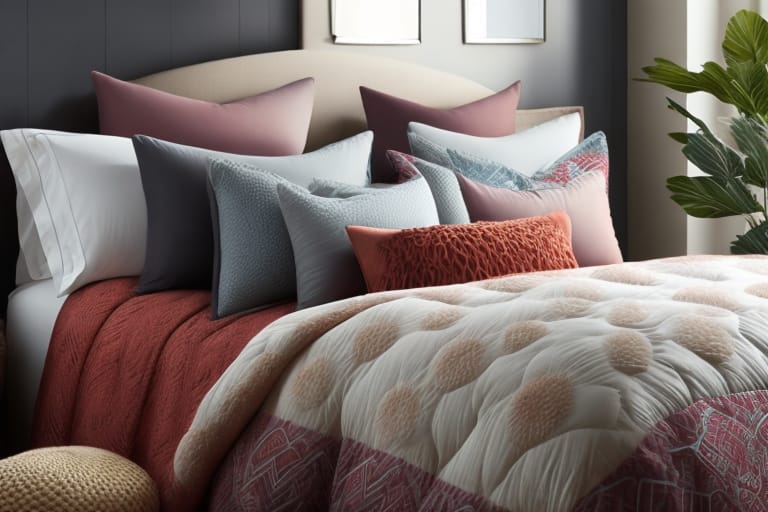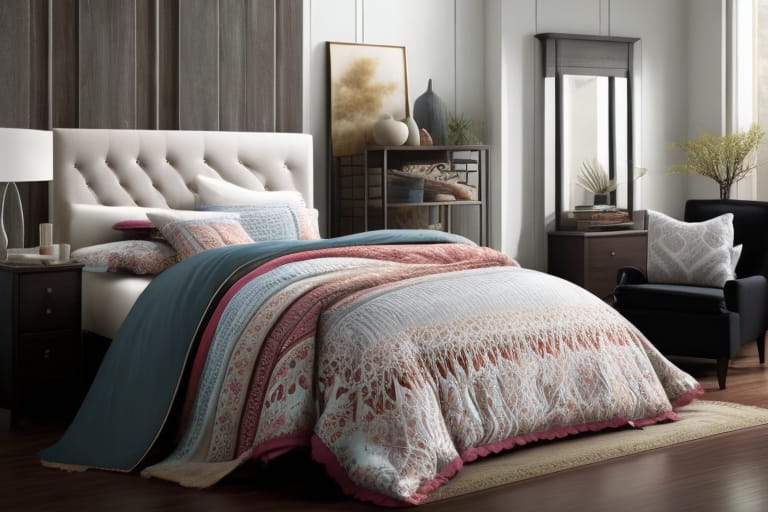When shopping for a cozy and insulating comforter, you may come across the term “down alternative.” This refers to comforters that mimic certain benefits of traditional down comforters, but without using any animal products.
So what exactly makes a down alternative comforter, and how does it compare to real down? This beginner’s guide will explain the key traits that define these popular bedding options. We’ll also discuss their pros and cons to help you choose the right comforter type for your needs and preferences.
An Introduction to Down Comforters
Before diving into down alternatives, let’s look at what makes regular down comforters so prized in the first place.
What is Down?
Down refers to the layer of fine, fluffy feathers found underneath the longer exterior feathers on ducks and geese. This undercoating helps insulate birds against cold temperatures.
- Down clusters trap air to create a warming barrier against chill. These feathery tufts also make down naturally soft and lightweight.
Why Choose Down for Comforters?
Down comforters offer exceptional warmth and coziness without a lot of weight. The fluffy fill creates insulation via lofty chambers that circulate heat back to your body.
This fill power, or capacity to trap warm air, varies based on the quality of down inside the comforter. Those small, fluffy clusters allow more trapped air and greater insulation.
That light-as-air feel makes down comforters popular among those who sleep hot but still want insulation without sweating. The loft space leaves room for body heat to dissipate instead of building up.
Down’s innate softness and squishiness also lend an extra-cozy quality, making it the fill of choice for luxurious bedding.
Understanding Down Alternative Comforters
Now that we’ve covered why down itself is so desirable in bedding, let’s look at how down alternative comforters aim to capture the same merits without feathers.
What is Down Alternative Filling?
A “down alternative” refers to any synthetic filling made from human-made materials to mimic qualities of natural down. These may include:
- Polyester fibers – For loft and insulation
- Microfiber fabrics like rayon or polyester – For softness
- Microfiber hollow fibers – For lightweight traps of body heat
Manufacturers craft these synthetic fills to optimize qualities like fluffiness, insulation, and low weight that also define down.
Comparing Down Alternative Comforters to Down
On the surface, many down alternative comforters do succeed in matching their natural down counterparts:
Fluffy appearance – Polyester and microfiber fibers get woven into billowy strands to imitate down clusters.
Lightweight warmth – Hollow synthetic fibers mimic down’s impressive insulation properties without hefty weight.
Gentle softness – Smooth woven microfibers can have a pleasantly plush feel close to down.
Hypoallergenic – Unlike feather and down bedding, synthetic fibers generally won’t trigger allergies.
Lower cost – With no sourcing of pricey rare down required, most down alternative comforters cost less.
Animal-friendly – For those avoiding animal-derived products, down alternatives offer guilt-free coziness.
So at a base level, down alternative comforters achieve a similar user experience as down comforters for sleepers wanting basic comfort at an affordable price point.

Differences Between Down and Down Alternative Comforters
However, down alternatives do fall short of natural down comforters in some performance areas worth noting. Being aware of these distinctions will help you choose your ideal comforter type.
Durability and Longevity
One major disadvantage of down alternative comforters is that they don’t last nearly as long as quality down comforters.
Down comforters can retain their loft and insulating value for 10-30 years if well-maintained. As the feathers age, their capacity for trapping air remains intact. Down is also quite resilient to repeated fluffing and washing.
In contrast, synthetic fills tend to deteriorate after several years of use. Microfiber and polyester fibers get compacted down with pressure and may clump into flat wads instead of retaining pillowy volume. They also become prone to tearing.
With their shorter lifespan of just 2-5 years typically, down alternative comforters end up being less of a long-term investment despite lower upfront costs.
Weather Adaptability
Down comforters also get the edge when it comes to adapting along with the seasons to keep you comfy.
The fluffy down fill’s impressive breathability allows it to keep you warm in the winter yet still remain cool enough for summer and transitional weather. The fill traps just enough body heat without overheating.
Meanwhile, synthetic fibers have less temperature regulation capacity. So down alternative comforters tend to cause sweating and heat build-up more easily, making them unsuitable for warm conditions.
That’s why 100% down comforters work well as the only year-round comforter option for bedrooms with fluctuating weather. Down alternatives do better when used situationally just for cold months.
Navigating Ethical and Budget Considerations
Beyond comparing functional pros and cons, there are some ethical and budgetary factors that may determine which type of comforter is the most sensible choice for different shoppers’ needs and values.
Prioritizing Animal Welfare
For some consumers, avoiding products derived from animals is an essential priority for ethical reasons.
Down raising practices remain controversial, with concerns about live-plucking of feathers before slaughter. And not all down gets certified as responsibly sourced.
So for shoppers making animal-conscious purchases, down alternatives offer reliable cruelty-free, vegan comfort. Those sworn off animal-based goods will appreciate these ethically made options.
Sticking to a Tight Budget
Cost and budget limitations may also dictate which comforter type makes realistic sense for a household.
As highlighted earlier, down alternative comforters pretty much always beat out down in affordability. Their synthetic fills skip the more complex production pathways to harvest prized down.
So buyers without much flexibility in their budgets will likely gravitate toward down alternative comforters as their most accessible option. A decent down comforter costs around $200 at minimum while synthetic versions start under $100.
Prioritizing price alone does mean giving up some long-term value. But for those furnishing spaces on a tight budget, down alternatives’ lower price makes coziness more immediately attainable.
Choosing the Best Comforter Type for You
Now that we’ve weighed some core considerations around down versus down alternative comforters, how do you decide which choice fits your sleep style and home best?
Keep these tips in mind as you evaluate options:
Recommendations for Hot Sleepers
- Choose down comforters – Their unbeatable breathability makes them ideal if you sleep warm but want insulation. The fill adapts well to dissipate trapped heat.
- Consider lower fill powers around 600 for optimal airflow. This prevents heat build-up while still being warming.
Tips for Allergy Sufferers
- Select down alternative comforters – Synthetic polyester and microfiber fills eliminate common allergens found in feather and down bedding.
- Check CertiPUR certifications to verify the hypoallergenic claims of manmade fills. This validates quality standards around chemical usage and processing.
Guidance for Animal-Conscious Shoppers
- Opt for down alternative comforters – Enjoy cruelty-free, vegan coziness free of ethical down sourcing concerns. Brands like COYUCHI specialize in premium down alternatives.
- Browse for RDS down options if you still prefer natural down’s benefits. Responsible Down Standard providers adhere to humane harvesting practices.
Recommendations on a Tight Budget
- Down alternative comforters give you the most comfort quality per dollar typically. Models like this one from LINENSPA start around just $30.
- Consider layering blankets for custom warmth instead of a pricier all-in-one comforter if needed to save money further.
Using these tips as a decision guide, zone in on the comforter type that best aligns with your sleep needs and home. Identify any must-have features then narrow from there until you find your ideal match.

Finding the Right Comfort for You
When breaking down the down vs. down alternative decision, neither choice is inherently better across the board. Selecting the best comforter depends wholly on what performance factors matter most to your lifestyle and values.
Frequently Asked Questions
What exactly is down alternative fill made from?
Down alternative fill is made from synthetic materials like polyester and rayon microfibers. These are engineered to mimic properties of natural down clusters. Common examples include silicone and microfiber polymers.
How much cheaper are down alternative comforters usually?
There’s typically at least a $100+ price difference. Quality down comforters almost never cost less than $200 while down alternatives start around $100 or under. For budget buyers, that lower investment makes a significant affordability impact.
Are down alternative comforters better for people with allergies?
Yes, down alternative comforters eliminate the concern of allergy triggers like dust mites in down since the fills use hypoallergenic synthesized materials. Those prone to down allergies will likely feel symptom relief switching to a down alternative.
Can you wash down alternative comforters?
You can safely wash down alternative comforters but be sure to follow any care instructions from the manufacturer. Most often, machine washing on a gentle, cool setting then tumble drying low will keep the fibers intact. Repeated high heat can damage the loft.
Why do down comforters last longer than down alternative?
The structure of down makes it extra durable and resilient against repeated use over decades. Down alternative fibers like polyester tend to compact down and tear after a few years with less shape retention. Lower longevity makes down alternatives less of a long term investment.
Is down or down alternative better for hot sleepers?
Down comforters better suit hot sleepers thanks to impressive breathability that prevents sweaty heat buildup. Down alternative materials retain more heat making them less adaptable for those prone to sleeping warm even in winter.
What’s the benefit of down alternative for animal conscious shoppers?
Down alternative comforters provide comparable coziness and insulation without needing to source animal products. This makes themaligned with cruelty-free values. Down production has ethical concerns around animal harvesting practices that brands like COYUCHI avoid with synthetics.








